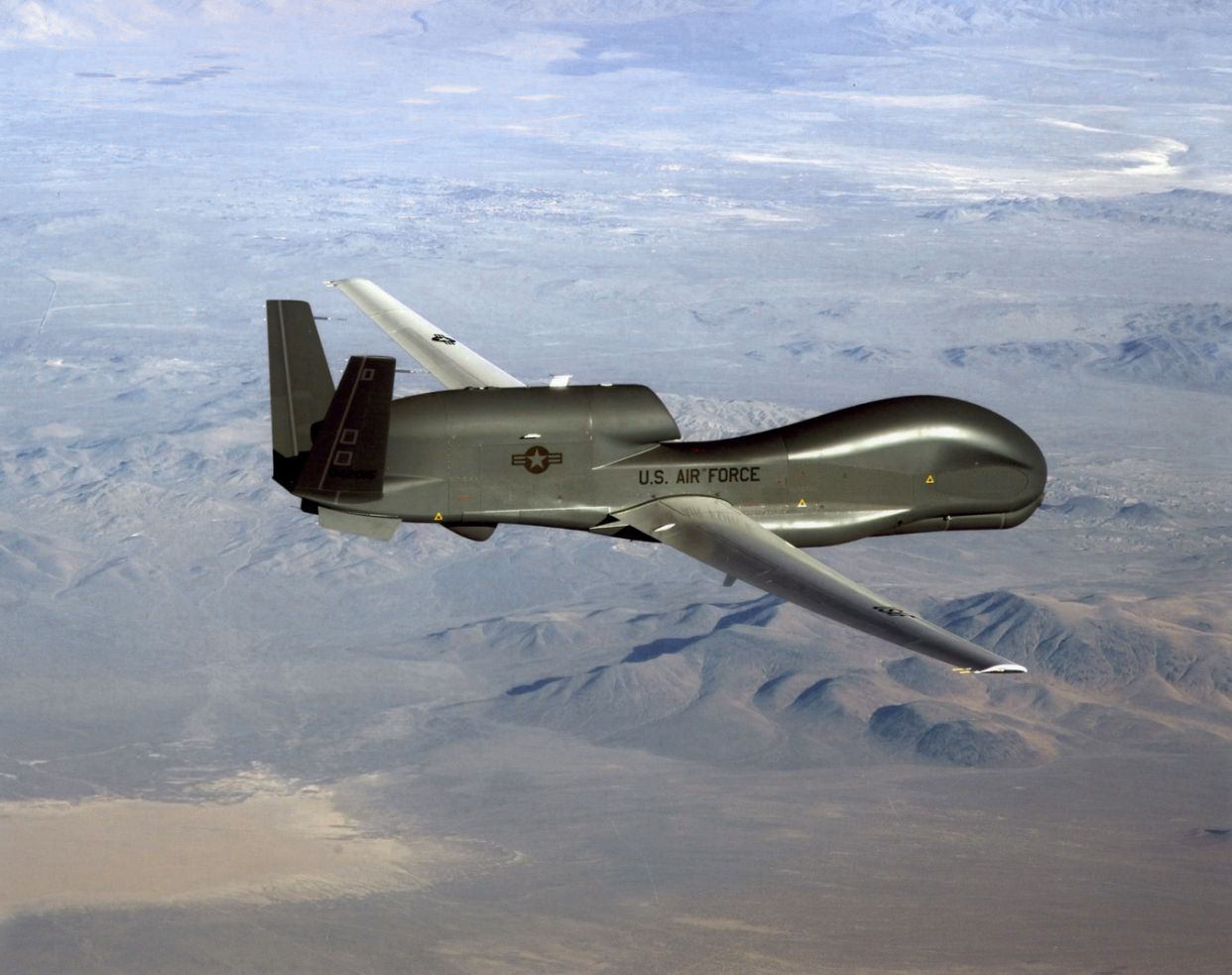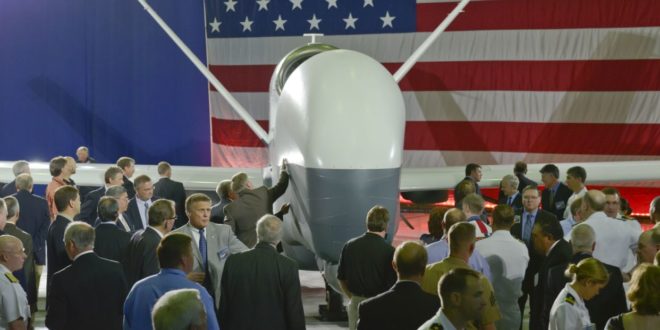Iran shooting down a U.S. surveillance drone in the politically sensitive Strait of Hormuz has created a dangerous new level of tension between the two countries
President Donald Trump said Iran made a “big mistake,” and later added that it was a “new wrinkle” for Iran and the U.S.
Days after saying that Iran attacked two oil tankers in the Persian Gulf, the United States is now accusing the country of shooting down an unmanned surveillance aircraft in international airspace. The Iranian Revolutionary Guard Corps declared that it had stuck down the RQ-4 Global Hawk over Iranian airspace, but the United States countered that the incident was an “unprovoked attack” and that the aircraft had been traveling in international airspace.
A few days ago, the U.S. officials also accused Iran of firing missile at a different drone that had been responding to the attack on the tankers.
But what exactly is an RQ-4A drone, and why does this attack matter? TIME spoke to drone aircraft experts to find out what you need to know.
What is the RQ-4 Global Hawk drone?
In technical terms, the drone that Iran shot down was a U.S. Navy Broad Area Maritime Surveillance (BAMS-D) aircraft, which is a Navy version of the Air Force’s high-flying RQ-4A Global Hawk. In simple terms, it is an unmanned aircraft that is intended for surveillance at sea.
Unlike the missile-launching MQ-1 Predator and MQ-9 Reaper drones that are used to conduct airstrikes, Global Hawk drones are unarmed are used only to collect information.
To do this, they fly at altitudes of up to 60,000 feet–– almost twice as high as a commercial airliner. At that height, the drone can see beyond the curvature of the Earth.
“This drone typically has as its most important defense altitude,” says Amy Zegart, a senior fellow at the Hoover Institution and Stanford University’s Freeman Spogli Institute of International Studies. “It flies at a very high altitude, so the fact that the Iranians were able to shoot it down shows that they have some pretty significant capabilities. In some ways, the shoot down is a signaling mechanism to the United States that Iran is more capable than we might have assumed.”
Global Hawks are also expensive, says Zegart. The cost of a single drone was more than $176 million in 2011, according to the military––more than 10 times the price of drones like the Predator and Reaper.
Global Hawks may be used for surveillance, but they’re not considered to be stealth aircraft. The drone has a 130-ft wingspan, similar to a Boeing 737 passenger jet. It is large, heavy and slow compared to combat aircraft, Dan Gettinger, the co-director of the Center for the Study of the Drone at Bard College, tells TIME.
“They’re not fast. They have a high profile––they’re easily observable on radar. They’re purposely designed to fly slowly at high altitudes. They’re able to essentially loiter over an area and collect as much data as possible,” Gettinger says.
Such an aircraft would be carrying advanced technology such as high definition and infra-red cameras, as well as sensors that can intercept telephone and radio chatter.
Douglas Barrie, a senior fellow for military aerospace at the International Institute for Strategic Studies tells TIME that this kind of aircraft would be sent on missions to conduct maritime surveillance or to peer inside a country from outside its borders.
“The range of the sensors onboard would allow you to see, certainly, areas of Iran of interest, while you’re still in international airspace,” Barrie says.
What happened to the drone?

The U.S. and Iran are telling conflicting stories. The Iranian Revolutionary Guard said that it shot down the aircraft over Iranian airspace. Revolutionary Guard’s Commander and Chief Hossein Salami said on Iranian TV that the U.S. aircraft crossed a “red line” and that Iran sent a message that it will respond to aggression, according to Reuters.
“Iran is not seeking war with any country, but we are fully prepared to defend Iran,” Salami said.
The U.S. Central Command, which is in charge of military operations in the Middle East, says the drone was attacked in international airspace at the Strait of Hormuz, which connects the Persian Gulf to the Gulf of Oman. The Strait is especially significant because much of the world’s oil supply flows through it.
“Iranian reports that the aircraft was over Iran are false. This was an unprovoked attack on a U.S. surveillance asset in international airspace,” Navy Capt. Bill Urban, a spokesperson for U.S. Central Command, said in statement Thursday.
Has this happened before?
Although it’s not unusual for smaller drones to face attacks, attacks on drones that are as large and sophisticated as the RQ-4 are rarer, Barrie says. Such aircraft fly at high altitudes and are hard to hit with short-range missiles.
Americans may remember that Iran allegedly captured a smaller drone––the RQ-170 Sentinel––in 2011.
Gettinger argues that what’s happening now is a very different, and that now there’s a higher risk of escalation. In 2011, the United States declined to claim the aircraft.
“It was a very secret drone on a secret mission,” Gettinger says. “Here, it’s a much more public event.”
What does it mean that a drone was shot down?
Zegart warns that while the diplomatic situation isn’t as dire as it would be if an aircraft with American pilots had been shot down, she considers Iran’s attack to be an aggressive move for Iran, especially since the drone wasn’t carrying weapons.
“It’s a signaling device that Iran has capabilities that we might not have anticipated before––but it’s certainly less aggressive than shooting at something that would risk human lives,” said Zegart.
U.S. efforts to collect surveillance don’t mean that the drone was being used in an aggressive way, she says.
“Regardless of where you come down on is this international airspace or Iranian airspace, this was not an escalatory move by the United States. It was an escalatory move by Iran,” Zegart says. “You can imagine in some circumstances, gathering intelligence can be deescalating, because everyone has a better picture of what’s going on on the ground. So the simple fact of sending a surveillance drone over a conflict area does not in itself lead to escalation necessarily.”
Zegart warns that the situation is “very dangerous” and that the Trump Administration should take the potential for escalating tensions seriously.
“The President’s use of Twitter is perhaps the biggest wildcard here,” says Zegart. “There are a lot of mixed messages coming out of the Administration whether you’re listening to the National Security Adviser or the President or the Secretary of State. So messaging discipline––which has never been a hallmark of this administration––is all the more important with this particular adversary. I think we can’t assume that an adversary like Iran is going to discount what the President says on Twitter is just Trump being Trump.”
Beyond the current situation, Gettinger, of the Center for the Study of the Drone, argues that the U.S. is likely to see more incidents like this. Drones are becoming increasingly popular in regions with high political and military tensions.
“Because of this proliferation of drones, and because of the perceived low risk of deploying them in these situations, there is a potential that we could see more of these incidents in the future,” Gettinger says.
 Unmanned Aerial Vehicle The latest drone news
Unmanned Aerial Vehicle The latest drone news




